In the first part of this series I wrote about fixing the broken screw arm post, removing a section of damaged or missing threads on each screw arm, and patching and re-drilling the hole for the depth adjustment locking thumb screw. Those things allowed me to test the plane out, as I successfully plowed a 1/2" groove.
 |
| First and only test groove made two years ago |
I knew then that there were other things that needed attention and I'm finally getting to them, as I'd love to get this plane into regular use with the new smaller-width irons I recently purchased.
There is nothing square about this plane. Maybe things were square when it was built, but now - not so much. I though a lot about what surfaces should be square and flat and decided on a few. First was the fence. The face of the fence that rides on the workpiece should be flat. And it should be square to the top surface of the fence where the screw arm posts are attached.
 |
| These two surfaces should be flat and square to each other |
Here's a closer view of the end grain of the fence. Check out the boxwood section dovetailed into the bearing face of the fence.
 |
| Boxwood wear surface was let into the fence |
Boxwood is used because it's a lot tougher than most woods. But this plane was apparently used extensively. If you look closely, you can see the boxwood surface is concave. It was worn down so much, the whole of the boxwood surface was far lower than the beech area, which would never touch the workpiece except when plowing very deep grooves.
 |
| That's a lot of daylight under the square |
After planing down a couple of high spots, I checked for twist.
 |
| Holy crap, Batman! |
I worked the two surfaces until they were twist-free, flat and square to each other. I was pleasantly surprised at how easy the boxwood was to plane. I thought it might be like planing purple heart or lignum vitae (neither of which I've planed, but have heard they're very hard). But it planed beautifully.
 |
| That's better |
The next area I worked on was the bottom surface of the plane body and the side wall to which the skates are attached. I first glued a small crack that I saw on a fragile area that could have popped off while planing. There was evidence that this area may have been patched before.
 |
| Arrow is at most fragile point |
I got the bottom flat and twist free, as well as square to the adjacent wall. This made the skates perpendicular to the bottom surface. Prior to working on that sidewall, the skates were not in perfect alignment with each other. But they are better now that the wall to which they are attached is flat.
 |
| Checking alignment by looking from end |
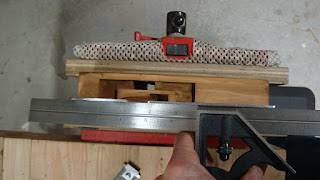 |
| And checking with a straight edge |
The bottoms of the skates that ride on the workpiece have a convex curve. I need to file them flat and parallel to the plane body's bottom surface. I'll get to that later.
One more area where flatness and squareness are important is the bottom of the screw arm post. This surface mates with the upper (and now flat) surface of the fence. Not only should this surface be flat, but it should also be parallel to the screw.
 |
| Testing for flatness with a straight edge |
Neither post had a flat bottom surface, so I marked high spots and started removing material. At first I used a block plane, but the surface is so small that I couldn't control the plane well enough. Then I tried using a scraper to remove high spots, but that also wasn't good enough. I finally went with sandpaper, pulling the arm assembly over the sandpaper to flatten it.
 |
| Flattening the bottom of the arm post |
I checked that the bottom was parallel with the screw by holding the post flat on the work bench and gauging with a ruler at both ends of the threads.
 |
| About 1 1/8" here ... |
 |
| ... and 1 1/8" here |
I assembled them with the fence and used winding sticks to see if the two screws were parallel with each other.
 |
| Shocking!! As good as I could have hoped for! |
I was very satisfied with this, but I'll still need to see if the fence's bearing face is parallel to the skate when the plane is reassembled. If not, I'll tweak the bottoms of the posts to get it right.
Aside from all these out-of-square issues, there was a small problem (that could be a large problem later) with the depth adjustment. The mechanism works fine, but the mortise that houses the brass plate that is screwed to the plane body is damaged.
 |
| Plate not seated properly in mortise |
 |
| Rear aspect of the area - note the crack at bottom right |
 |
| Front aspect - smaller crack bottom left |
I believe the locking screw has been clamped so hard on the depth adjuster that it has blown out the thin wall on the left side of the mortise (at the bottom in the above pictures). You can see the crack that has formed, especially at the rear. The locking screw works as in the following picture.
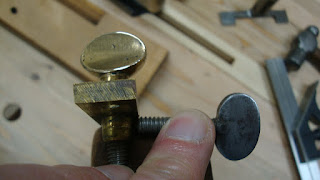 |
| Locking thumb screw pinches the brass portion below the plate so the adjuster can't be turned |
 |
| It pushes the whole mechanism against the thin wall at left side |
In the following picture, I've removed the screws and pushed the adjuster into its proper position.
 |
| Adjuster in proper position |
If you look closely into the screw hole, you can see the hole has been worn to an off-center position.
 |
| Can see the hole in the plane body is off-center from the brass hole |
So I decided to drill out the screw holes, plug them, and re-drill them, hopefully with better centers.
 |
| Cutting some plugs in beech - needed two for each hole to get enough length |
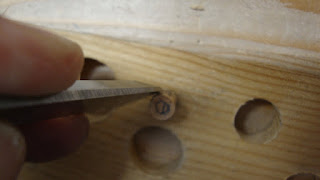 |
| Shaved them a bit since they are tapered from the plug cutter and I don't want to wedge the plane body apart |
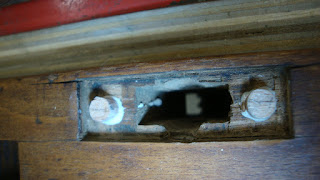 |
| Two plugs glued into each hole |
I used a router plane to flush them up after the glue had set. Notice on the sidewall down inside the mortise hole there are drops of glue squeeze-out. Apparently the stresses applied by the locking screw were enough to crack apart the body in this area. So I clamped the whole plane body in a bench vise until the glue set up. Maybe the glue that squeezed into the crack will seal it.
When the glue had set, I drilled new holes for the screws, trying to be as accurate as possible. I also tried to get some superglue into the cracks along the thin wall and clamped it in the vise to pull that wall back in.
 |
| Holes drilled and superglue applied in cracks |
Finally, I glued a couple of thick shavings into the void on the left side where the plate had shifted to. The depth adjuster is being used as a clamp to hold these shavings in position.
 |
| Shavings glued into to open area on left. |
And here's how it came out. The cracks near the thin side closed up a bit and the whole mechanism is in a better position.
 |
| Looking much better |
 |
| Blurry pic from the other angle |
After the plane was reassembled, I checked the fence for parallel with the skates. Couldn't be happier with that.
 |
| Looks pretty good, but lets measure |
 |
| Just shy of 12/32" at top |
 |
| Just shy of 12/32" at bottom - BANG ON!! |
The the skates had to be filed flat and parallel to the bottom of the plane.
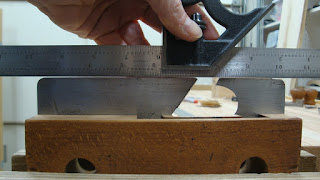 |
| Before filing - lots of light coming through at front and back |
This took only a few minutes with a flat file, followed by light sanding. Then it was time to try making a groove. Still using the original (to me) 1/2" iron, which was perfectly sharp from a couple years ago.
 |
| Not bad |
I started at the far end and gradually moved backward, taking longer shavings. It was little difficult and the iron dug in and removed too much material at the far end. But I can tell this plane will require practice. And I can't wait to see how it works with the narrower irons.
The next post will be about the irons and wedge.

































Depending upon how this comes out for you, I may be adding a wooden plow to the herd. I have a set of plow plane irons (1-8) and I'll compare them to your next post to see if they match up.
ReplyDeleteWell, I'm having trouble with the next part. The irons I bought might just be garbage, so much so that I might see if I can get a refund. You can read all about it in a few days.
DeleteIf you do end up buying a wooden plow plane, think about the wedge arm or center wheel or other types - the screw arms might be more trouble than they are worth. They sure do look cool, though.
A commun problem when you start switching irons in those planes, is the fact that the cutters are tapered and there is of course no standard, that may required a slightly different angle on the wedge in order to lock the iron correctly. Since you would be making a new one, watch out for the taper angle on your cutters. Another problem area is with the centering groove in the back of the cutters. These were done free hand and some are really wonky... the groove is v shaped in the bottom, to center on the skate. Being made by hand the location of the groove varies from cutters to cutters, but in practice it does not seem to make a difference, except that the fence setting would of course be slightly changed.
ReplyDeleteBob, breathing better
Thanks Bob. I've read about this and was prepared to make multiple wedges. The irons I bought are from all different makers - from the U.S., U.K. and France. I had read that US and UK makers used different taper angles. But I had also read that most makers made irons to fit the common planes, like Ohio Tool Co. planes. I might be better off finding a set of Ohio Tool irons, but I'll end up paying 3-4 times what the plane cost me to begin with!
DeleteAgree with your statements on the centering grooves. The ones I bought are all different. Some deeper than others, some not perfectly centered. The centering isn't what bothers me - it's whether or not the iron will seat properly on the skate.
You got that right Matt, buying a set of 8 tapered plow irons often cost more than the tool you bought... True of most plane's spare parts :-(
ReplyDeleteIf the groove is not quite right for your skate thickness, you can easily widen the V shape groove with a file. Go easy and check often until you got a good fit.
Bob, now over the dripping nose phase... Somebody shoot me to take me out of my misery :-)
Thanks for that, Bob. But of the converse problem - you can widen a groove, but you can't narrow a groove if the skate is too loose. Still thinking about what to do.
DeleteDitto on what Bob said. If you know the maker of the plow, ask Josh at Hyperkitten if he has a set of them.
ReplyDeleteOK, thanks for the tip.
DeleteHummm, being V shaped, once corectly locked in by the wedge, should be OK?
ReplyDeleteBob, who may be delirious under the influence of medications :-)